Stringed instruments are my favourite out of all the instruments (other than the piano). However, they come with some downsides and one of those downsides is tuning issues. There are a few reasons why this happens, but in my experience, guitar strings typically go out of tune because they’ve been wounded improperly.
This might not be the case for you, however. In fact, another reason why they can go out of tune has to do with the weather or climate where you live, surprisingly. There are others too.
Generally speaking, guitar strings go out of tune due to a variety of factors including improper winding of the strings, fluctuations in humidity and temperature, use of old or damaged strings, insufficient stretching of new strings, a poorly cut nut, or an improperly set up tremolo or bridge.
Yes, there are many reasons why your guitar goes out of tune, but I find that having wound them improperly is a big one. This is something that even I struggle with after about 15 years of guitar playing.
When stringing the guitar up, you have to wind the strings around the tuning peg in such a way that it wraps around at least 2-3 times and then ties off there. You can see what this looks like in the image below:
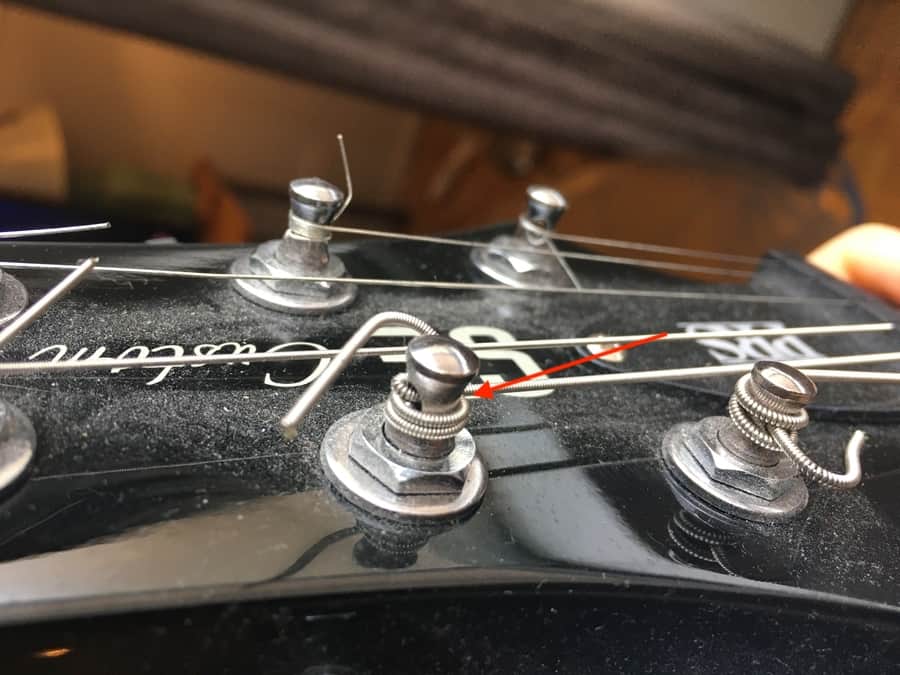
Compare and contrast this image to a string that’s wound improperly.
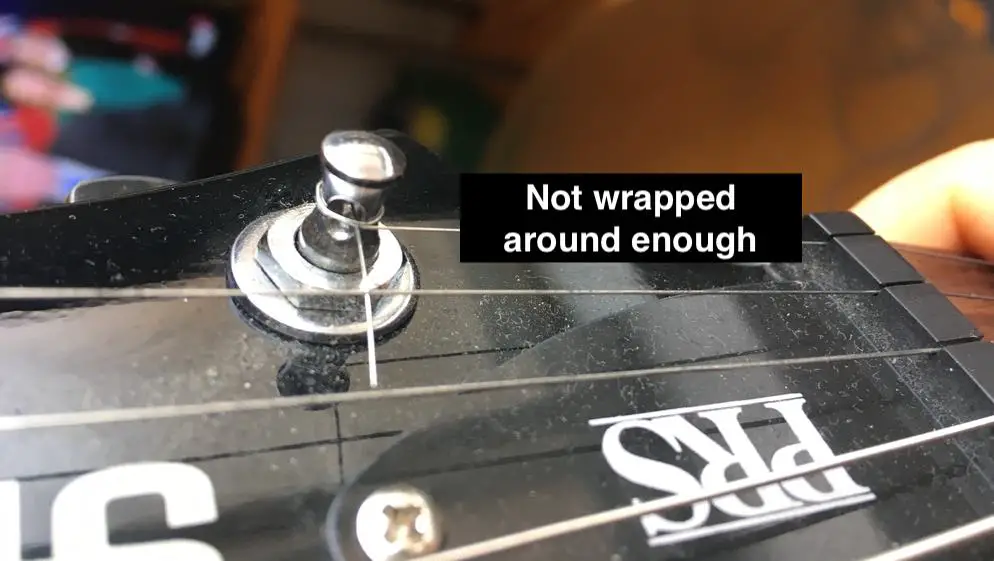
Both of these images come from my guitar actually. Stringing a guitar properly is one of the things that I still don’t do perfectly every time because I’m so impatient.
Additionally, you want to ensure that you’ve actually wound them in the right direction, for instance, turning them counter-clockwise should tighten the string and tuning them clock-wise should loosen the string.
Explained in another way, you want the strings to be wound so the string is wrapping around the peg from the right-hand side of the tuning peg, and then on the other side of the headstock, they should be wrapping around the peg from the opposite side.
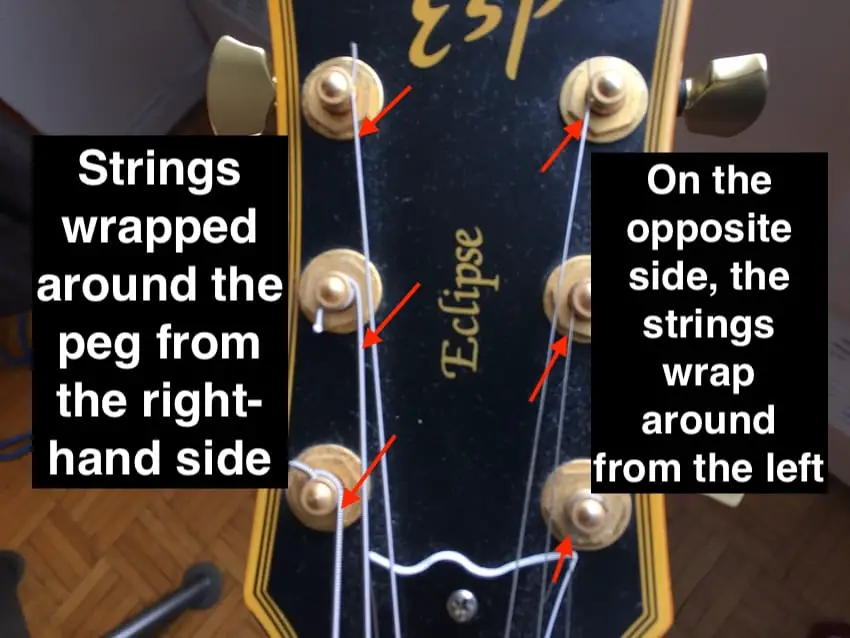
In my experience, this is the main reason why guitars go out of tune, at least for beginners to guitar playing and set-ups.
Of course, there are other very significant factors.
Make sure to check out the YouTube video at the end of the article, because there is a way to actually lock the strings around the tuning peg.
The way the string is wound around the tuning peg in the first image of this article is fine, but locking the string using the method shown in the YouTube video is the best way.
***On a Fender Strat or a guitar with a similar headstock, the strings will wrap around the tuning peg in the exact same way on every string.
Why Do Guitar Strings Go Out Of Tune
1) Humidity and Temperature Changes
Your guitar may also be going out of tune due to the expansion and contraction of the guitar’s wooden body from changes in humidity and moisture in the environment.
This leads to the strings either being pulled tighter against the body or relaxed, depending on whether the wood has absorbed or released moisture.
If you think about it, it makes a lot of sense.
In addition to being very conducive to sound, wood is good at releasing and absorbing moisture.
This is the other main reason why traveling guitar players have to re-set their guitar once they’re in a new environment.
Hypothetically speaking, if you play a gig in Alaska during the coldest and driest month of the year, and then get on a jet and fly to Miami in the middle of July where it’s 80% humidity, your guitar is going to take on that moisture and go out of tune for the reason I mentioned above.
The guitar’s wooden body is going to absorb the Miami moisture, causing the guitar to go too sharp.
Moisture absorption causes the guitar to go sharp, and the release of moisture causes the strings to go flat, due to the amount of tension on the string.
This is one of the reasons why some professional guitar players purchase a special case that has humidity control right inside of it. It keeps the guitar nice and stable.
There are other things guitar manufacturers do, like Suhr, who I believe sprays the guitars with a special coating that makes it less susceptible to moisture.
According to Guthrie Govan, Suhr has to ship out the guitars to a different state and have them sprayed with a special compound there because the spray isn’t allowed in California.
Moving on, there are other reasons why your guitar may be going out of tune. Humidity and moisture aren’t the only factors at play.
2) The Nut
The nut is where the guitar strings sit on the very top of the fretboard near the headstock.
The nut on my ESP needs to be filed down a little bit, because, as you can see, the heavier strings are kind of sitting on top of the slot, rather than inside the slot.
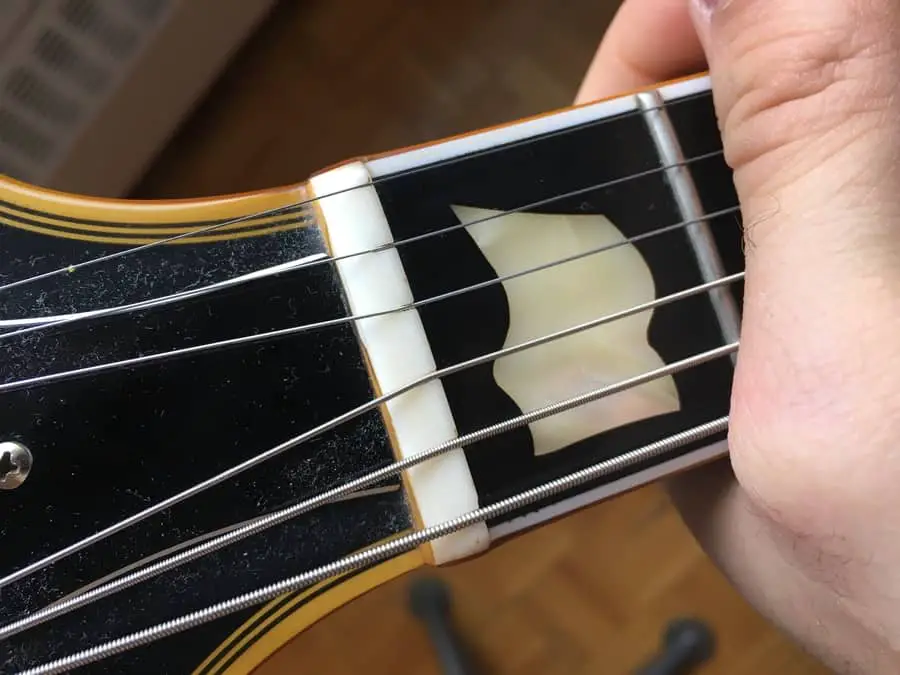
It’s very possible for the nut to be filed improperly, perhaps too deep, or not deep enough, which will lead to the strings being out of tune all along the neck.
When it comes to this sort of adjustment, you’d be better off to take the guitar to a luthier who can file the nut properly. Another thing that can be done is to change the nut completely.
I’ve written about this before, but there are a lot of different kinds of nuts out there, including plastic, bone, ivory, and even brass notes, which cause the guitar to sound a lot brighter.
Depending on what thickness of strings you use, may actually have to file the nut a little bit so thicker gauge strings fit.
3) Old and Worn Out Strings
It’s also possible that you just need to change your strings. A lot of guitar players will never, ever change their strings, or they won’t do it often enough.
Eventually, the guitar will sound lifeless, dull, and just not that great. Depending on how often you play, it’s probably not a bad idea to change the strings on your guitar every two months.
Some people even say that it’s best to change them every month, but as I just mentioned, it depends on how often you play the instrument.
Old and worn-out strings can slowly deteriorate and lose their ability to hold tension, either becoming brittle or developing a thin layer of tarnish and guck on them.
Eventually, the strings simply won’t hold tension as well as they use too, which means they’ll probably go flat on you all of the time.
If you’re in the market for strings that last a long time, I think Elixir makes probably some of the greatest strings out there for that, however, they tend to be around twice the price.
They’re sprayed with a special coating that makes them less susceptible to tarnishing and wear-and-tear.
4) Poor Intonation
Intonation refers to how the guitar is tuned all the way up and down the neck, for instance, the pitch of the open string in comparison to the same string on the 12th fret.
These two notes should be the exact same pitch, or at least extremely close. To check your intonation, grab your tuner and play an open string.
On that same open string, bar the 12th fret and pluck the harmonic with your tuner still plugged in.
The idea behind this is to compare and contrast the two notes and make sure they’re the same pitch or at least as close as possible.
In other words, the open E-string is the same note as the 12th fret on the same string, just at a different octave. These two notes should be very, very similar.
This article isn’t about adjusting the intonation, so we’ll explore how to do it in another tutorial someday, however, in brevity, intonation adjustments are typically adjusted at the bridge on the bottom of the guitar.
It’s worth mentioning that the intonation is also affected by the truss rod, and how it’s been adjusted. If there is too much relief or too much back bow, the intonation might be thrown off.
I wrote more about determining the amount of relief and back bow in this article here.
5) Loose Tuning Machines
The tuning machines are the little knobs on top of the guitar headstock that are used to either tighten or loosen the strings, most of which are universal, unlike other knobs, by the way (my guide on that).
Every once in awhile, it’s good practice to grab a star-screwdriver and tighten the tuning pegs, otherwise, they won’t hold the string in place that well.
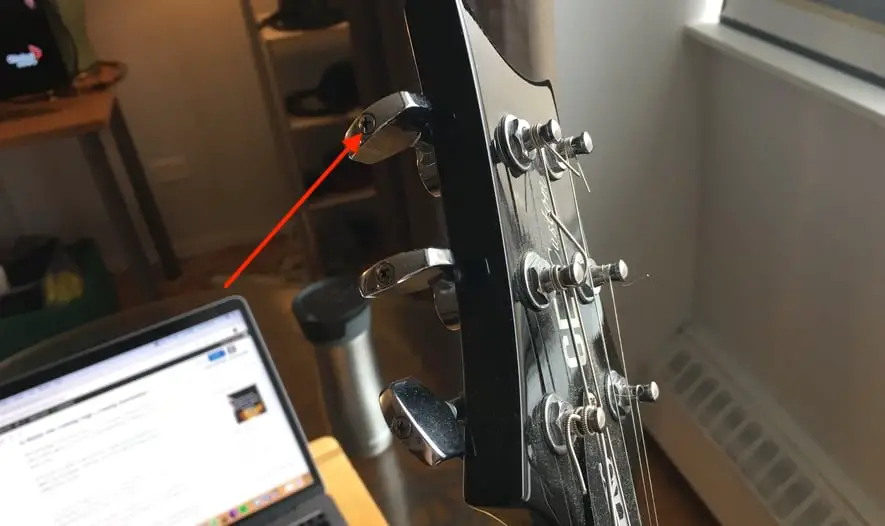
It’s not hard to imagine how a loose tuning peg affects the tuning. If they aren’t fastened to the body, the string will kind of move around in the tuning peg and they don’t hold a tune properly.
Make sure you have a screwdriver handy that way you can make proper adjustments. If you don’t have the proper equipment to make adjustments, just go out and grab what you need to.
As the years go by, you’ll have enough tools to make any adjustments you need. Just make sure you’ve purchased the right tools, because the correct tools are always essential, regardless of what you’re fixing.
6) Tuning The Strings From An Improper Direction
This is another huge culprit when it comes to guitar string tuning.
In general, you always want to make sure that you tune the guitar strings upward to the correct pitch, rather than downward to the correct pitch.
Explained in another way, if your guitar strings are a bit too sharp, tune it downward by a lot, and then tune the string upward to meet the correct note and pitch.
Don’t just tune the guitar string down to the note. Always tune UP to the note.
7) Pull-On String After Winding Them
This is another weird tactic that I was taught by my guitar teacher a long time ago.
Whenever you put new strings on a guitar, it’s a good practice to actually pull on the string, either by running your hand along the string at various points of the neck and pulling it up away from the body.
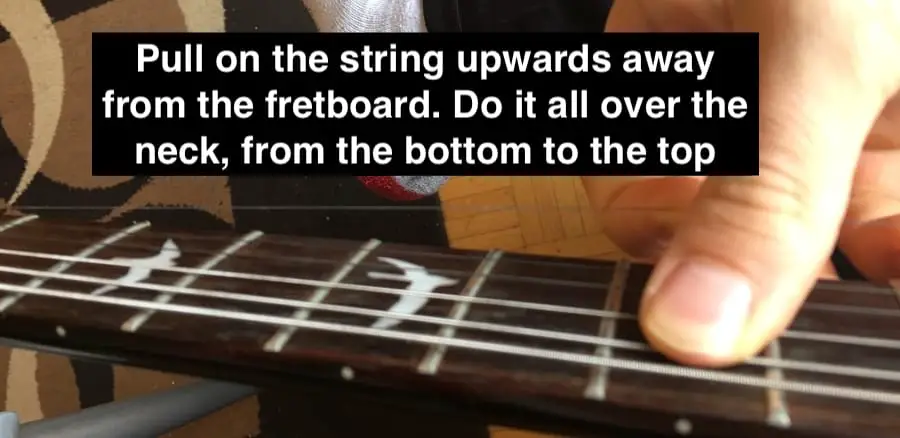
Another thing that you can do is just do big bends on the string at various points and then tune it back to where it should be. Continue doing this over and over again until, eventually, the guitar string is able to stay in tune, even after doing a big fat bend.
8) Improper Tremolo Set Up
If your guitar has a tremolo system, whether it be a standard tremolo system or a Floyd Rose, it’s important to ensure the strings are set-up correctly, otherwise, you’re going to run into some issues.
For instance, if the strings are wound improperly around the tuning pegs, whenever you press on the tremolo system, you may run into a problem.
How the string moves around in the nut will contribute to this phenomenon, so make sure you’ve wrapped them properly around the tuning peg and also done so properly on the bottom of the instrument.
Other Articles You May Be Interested In
- What’s the Difference Between Light & Medium Guitar Strings?
- How Tight Should Guitar Strings Be? [ANSWERED]
- Guitar Nuts Are Typically Universal With Some Exceptions
- Why Does The B String On The Guitar Sound Out Of Tune?
- When Are Guitar Strings Dead?
YouTube Video
For this section, rather than making my own YouTube video, I used Rhett Shull’s because he has a section in his 10 Guitar Hacks You NEED to Know that is great.
It shows you how to string the guitar and also lock it to avoid strings slipping and going out of tune.
It starts at 2:28 on the video.
Conclusion
All of the issues and solutions I mentioned above should be enough to figure out why your guitar is persistently going out of tune.
In some special cases, there might be another reason, but I’m fairly certain that if you just make sure you’re not guilty of any of the aforementioned problems, the guitar will stay in tune.

 Written By :
Written By :